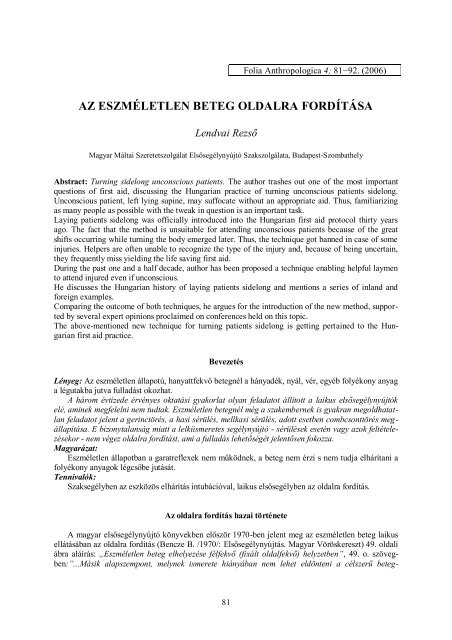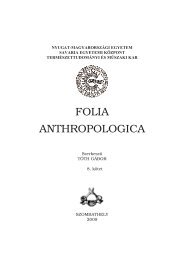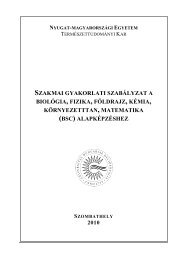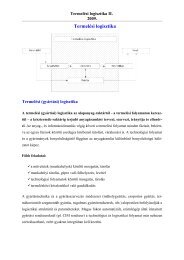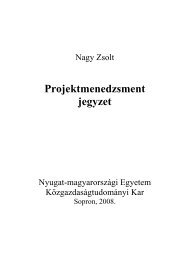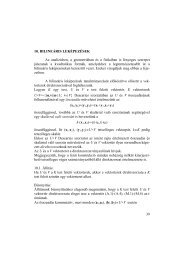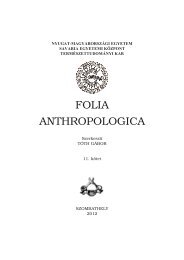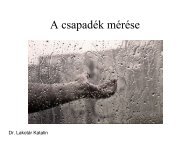You also want an ePaper? Increase the reach of your titles
YUMPU automatically turns print PDFs into web optimized ePapers that Google loves.
Folia Anthropologica 4; 81−92. (2006)<br />
AZ ESZMÉLETLEN BETEG OLDALRA FORDÍTÁSA<br />
Lendvai Rezső<br />
Magyar Máltai Szeretetszolgálat Elsősegélynyújtó Szakszolgálata, Budapest-Szombathely<br />
Abstract: Turning sidelong unconscious patients. The author trashes out one of the most important<br />
questions of first aid, discussing the Hungarian practice of turning unconscious patients sidelong.<br />
Unconscious patient, left lying supine, may suffocate without an appropriate aid. Thus, familiarizing<br />
as many people as possible with the tweak in question is an important task.<br />
Laying patients sidelong was officially introduced into the Hungarian first aid protocol thirty years<br />
ago. The fact that the method is unsuitable for attending unconscious patients because of the great<br />
shifts occurring while turning the body emerged later. Thus, the technique got banned in case of some<br />
injuries. Helpers are often unable to recognize the type of the injury and, because of being uncertain,<br />
they frequently miss yielding the life saving first aid.<br />
During the past one and a half decade, author has been proposed a technique enabling helpful laymen<br />
to attend injured even if unconscious.<br />
He discusses the Hungarian history of laying patients sidelong and mentions a series of inland and<br />
foreign examples.<br />
Comparing the outcome of both techniques, he argues for the introduction of the new method, supported<br />
by several expert opinions proclaimed on conferences held on this topic.<br />
The above-mentioned new technique for turning patients sidelong is getting pertained to the Hungarian<br />
first aid practice.<br />
Bevezetés<br />
Lényeg: Az eszméletlen állapotú, hanyattfekvő betegnél a hányadék, nyál, vér, egyéb folyékony anyag<br />
a légutakba jutva fulladást okozhat.<br />
A három évtizede érvényes oktatási gyakorlat olyan feladatot állított a laikus elsősegélynyújtók<br />
elé, aminek megfelelni nem tudtak. Eszméletlen betegnél még a szakembernek is gyakran megoldhatatlan<br />
feladatot jelent a gerinctörés, a hasi sérülés, mellkasi sérülés, adott esetben combcsonttörés megállapítása.<br />
E bizonytalanság miatt a lelkiismeretes segélynyújtó - sérülések esetén vagy azok feltételezésekor<br />
- nem végez oldalra fordítást, ami a fulladás lehetőségét jelentősen fokozza.<br />
Magyarázat:<br />
Eszméletlen állapotban a garatreflexek nem működnek, a beteg nem érzi s nem tudja elhárítani a<br />
folyékony anyagok légcsőbe jutását.<br />
Tennivalók:<br />
Szaksegélyben az eszközös elhárítás intubációval, laikus elsősegélyben az oldalra fordítás.<br />
Az oldalra fordítás hazai története<br />
A magyar elsősegélynyújtó könyvekben először 1970-ben jelent meg az eszméletlen beteg laikus<br />
ellátásában az oldalra fordítás (Bencze B. /1970/: Elsősegélynyújtás. Magyar Vöröskereszt) 49. oldali<br />
ábra aláírás: „Eszméletlen beteg elhelyezése félfekvő (fixált oldalfekvő) helyzetben”, 49. o. szövegben:”...Másik<br />
alapszempont, melynek ismerete hiányában nem lehet eldönteni a célszerű beteg-<br />
81


